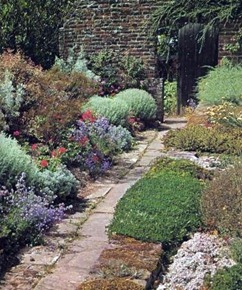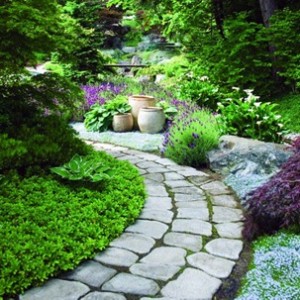





In the context of this website paths are for people living in 20th-century, westernised society. They are not, as it might often be thought for animals who tidily put one foot in front of the other, or indeed for tribal humans proceeding single file ‘Indian style’. It should also not be forgotten how billowing plants narrow a path.
Paths are for convenience, access and, above all, for use. Size, material, position of this facet of the garden compendium is extremely basic to the success of the garden as a whole. For this reason one has to be extraordinarily sure of the initial rightness of any decision to concrete paths, so the dreadful permanence of solid concrete is best avoided at least for some time. Yet hard, dry walking is essential if you are to move around the garden conveniently and with pleasure. Yet again in a small garden it is unlikely that a disproportionate amount of space can be spared for the purely utilitarian service purposes that dry shod walking entails. Several general facts might be kept in mind, the more important of which can then be combined in any specific design.
 Paths must clearly go somewhere and go there with dispatch. Those, which, like Coleridge’s River Alph ‘… meander with a mazy motion …’ waste space, and will with certainty be disregarded by all but drunken users. Even fine straight paths are of no use if there is a quicker or more desirable route between the points ostensibly being serviced. This is often graphically, and lamentably, seen by the paths of winter mud criss-crossed across patches of grass in too many housing estates. Notices and fences alike are no permanent barrier to convenience.
Paths must clearly go somewhere and go there with dispatch. Those, which, like Coleridge’s River Alph ‘… meander with a mazy motion …’ waste space, and will with certainty be disregarded by all but drunken users. Even fine straight paths are of no use if there is a quicker or more desirable route between the points ostensibly being serviced. This is often graphically, and lamentably, seen by the paths of winter mud criss-crossed across patches of grass in too many housing estates. Notices and fences alike are no permanent barrier to convenience.
Paths also inevitably provide sightlines, or, in more aesthetic terms, vistas. These visual bones of design should look good on the ground and end in something worth looking at. Or, alternatively, if the final point is not good to look at then the main line of the path must be turned. For example, a compost heap is going to need ease of access; it is also apt to be sited at the very end of the garden. A suitable end of vista eye-catcher is sited at the turn, while the utilitarian necessity what-ever-it-is no longer steals the show.
These of course, are vital if paths are to perform their necessary function. Inevitably the spectre of cost raises its formidable head: any solid material is expensive. Hence the right choice for the sort of garden that is being planned is of especial importance. Much of the price nowadays is concerned with delivery costs so that local materials or locally made materials should always be looked at first. Only if they are quite unsuitable should it be necessary to have to look far afield. Anyone planning a garden today can only despair at recommendations seen in websites written between the wars when sawn York paving was universally used and cheap to buy. There are still acres of London pavements made with this covetable material.
There is no point either in leaping to the other extreme of cost and deciding that grass paths will have to do. As an access between borders with no traffic other than that of the occasional cultivator or admirer nothing could be better, but wear quickly shows. And as use increases grass paths will need to be disproportionately wide to cope with the flow of people. An added difficulty is on soils which lay wet in winter; here grass paths quickly turn to unacceptable quagmires with need for much subsequent, time-consuming renovation. In small gardens the answer must be ‘don’t’. However, lawns which are crossed regularly without being main paths can have inset stepping stones.
Practical paths, then, are to be hard paths. If natural stone is impossibly expensive (but do examine local possibilities), recourse to concrete slabs is not only necessary but usually very satisfactory indeed. It has advantages too: the slabs are of a definite size and thickness and are thus relatively easy to lay. Quality, of course, varies. Some are variously textured to resemble natural stone more or less successfully, but they may be obtained in colours of the rainbow and unfortunately they often are. Unless it is wished to live in the middle of a Neapolitan ice-cream, the quieter colours — and probably no more than two in combination — should be chosen. Choice should be made not merely because colour A is preferred to B (though this is important), but with the consideration of what suits best in the situation. These are discussed at greater length in the section on terraces.
The cheapest slabs are usually simple uncoloured grey concrete ones. These are admirable for service paths: where they are more visible they are immediately brought into another category by being framed in bands or edges of brick setts or small cobbles (the latter at points not walked upon). This same artifice is the only way to make crazy paving acceptable. Certainly broken paving slabs from the local authority dump have their uses — though seldom really as cheap per square metre as might be thought.
It is difficult material to use well in any but a country cottage situation.
Stone or concrete slabs are available in sizes that can be combined to enliven the most starkly functional path. Some possible combinations are suggested here: in practice the whole pattern should be drawn out on paper so that the exact number of slabs can be ordered.
 Normally slabs are best laid upon a 5cm (2in) layer of firmed sand laid over firmed soil. Subsequent cement grouting where no plant growth is to be permitted in the cracks helps to hold them in place. The likelihood of slight falls or irregularities developing over the years is a small price to pay for the adaptability of paths not irrevocably laid in concrete (and at greater expense).
Normally slabs are best laid upon a 5cm (2in) layer of firmed sand laid over firmed soil. Subsequent cement grouting where no plant growth is to be permitted in the cracks helps to hold them in place. The likelihood of slight falls or irregularities developing over the years is a small price to pay for the adaptability of paths not irrevocably laid in concrete (and at greater expense).
Levels should be chosen with care. When bounding grass, paths should be marginally lower so that a mower can cut right to the edge with its roller on or overhanging the path. Against cultivated ground, be it flower border or vegetable plot, the path needs to be at permanent soil level. If soil starts to need to be banked up to avoid mess and spillage much space is wasted. Ultimately, small retaining walls could be necessary.
Other materials are possible. Rolled gravel as it weathers gives gentle contrast to plants but is difficult to maintain as the relatively narrow paths of a small garden. It is also suitable as a larger area for general access. Modern weedkillers no longer sentence gravel to be labour intensive as it once was (how many great gardeners have claimed that their careers started on gravel drives with broken dinner knives in their grubby hands?). Gravel’s porous surface does permit plants to germinate and grow down and in controlled conditions offers a splendid site for Mediterranean and other plants that like a baking.
In less formal situations walks through flower beds or shrub borders can be made with a sprinkling of pea-gravel or of bark chips. Whatever the level of access needed to any given point, a suitable material can be found, not necessarily at inordinate cost.
Copyright © www.100flowers.win Botanic Garden All Rights Reserved